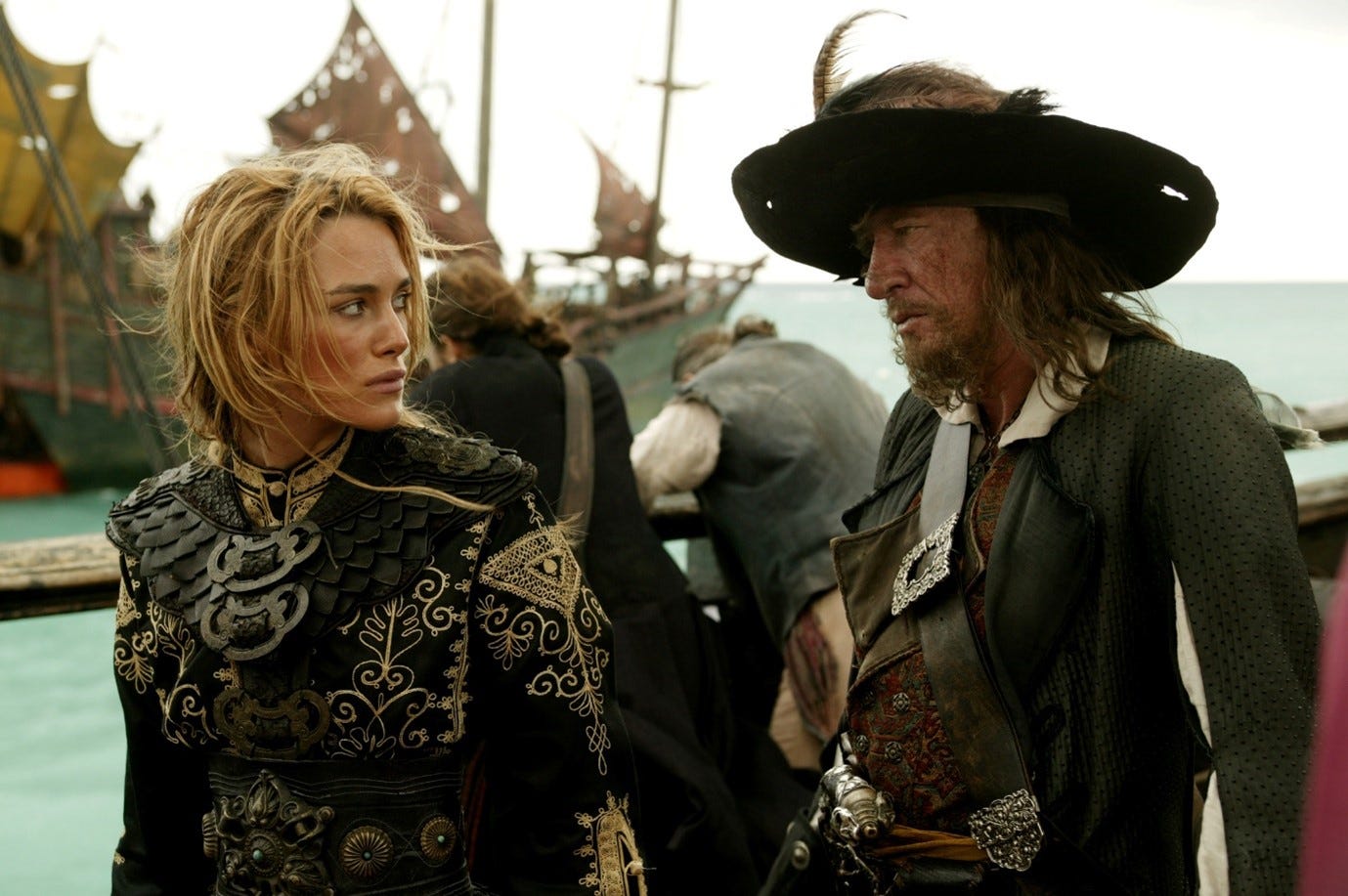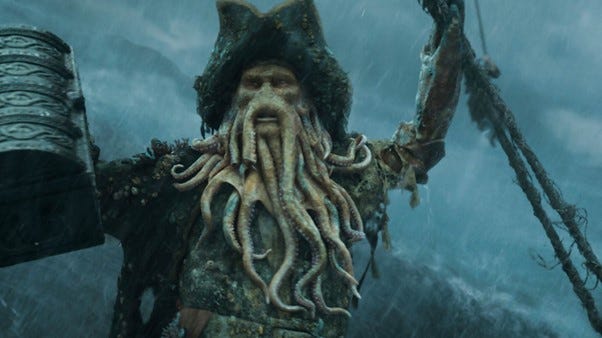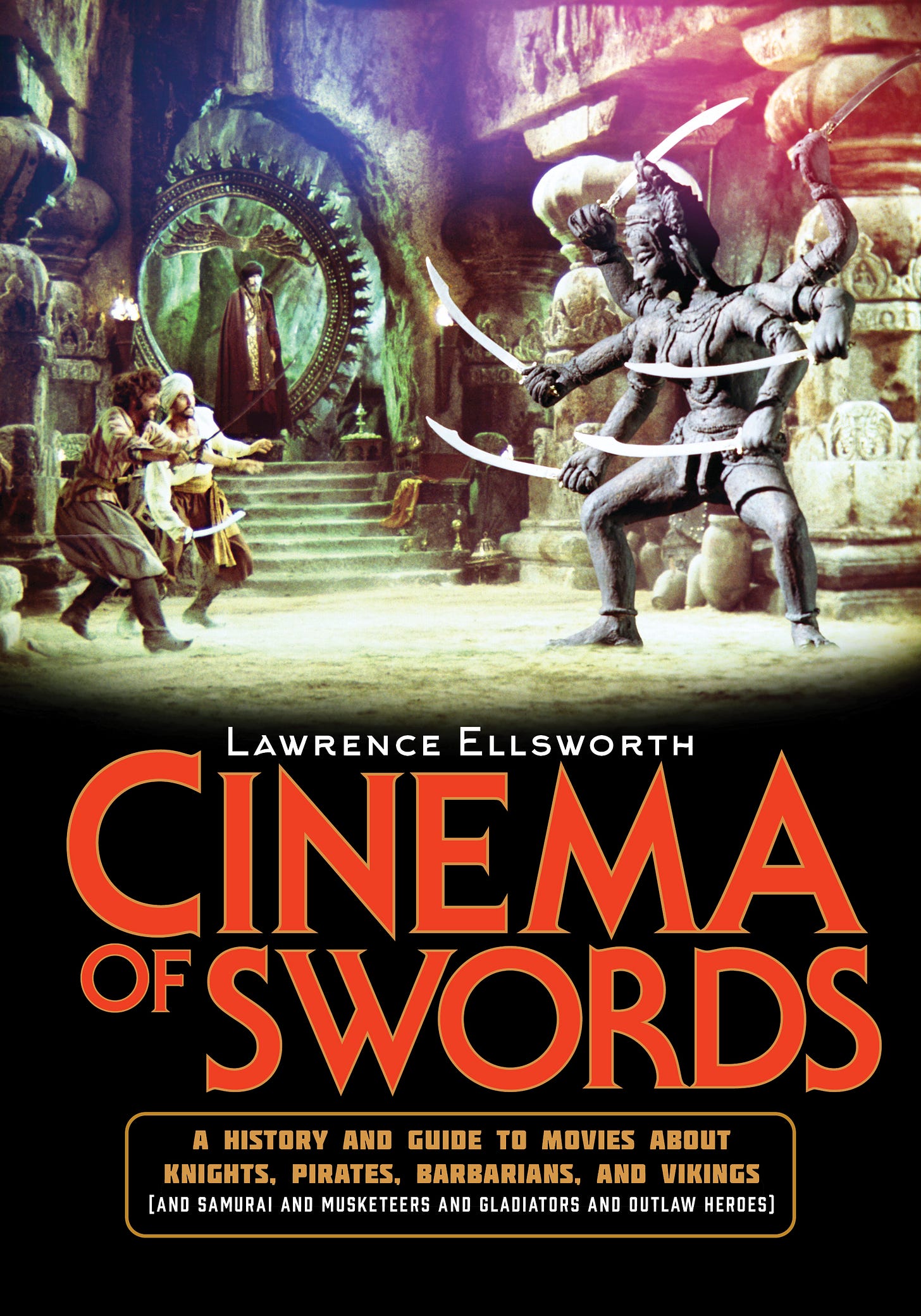Cinema of Swords
A Popular Guide to Movies about Knights, Pirates, Samurai, and Vikings (And Barbarians, Musketeers, Gladiators, and Outlaw Heroes)
By Lawrence Ellsworth
Parry; Disengage
This is the final post in the Cinema of Swords Substack, at least for the foreseeable future; I am suspending subscription and publication due to Your Cheerful Editor’s worsening health issues, which have rendered making weekly posts unreliable and problematic. New subscribers will no longer be accepted. I apologize, but more importantly, I want to thank you for your support over the last year and half. This has been fun, but circumstances are forcing me off the treadmill. I will continue to work in the background on further reviews until we have enough for a second volume of Cinema of Swords, which aims to cover swordplay movies from the ‘90s through 2019 and season eight of Game of Thrones. Wish me luck! And the best of luck to you all as well!
Sharpe 16: Sharpe’s Peril
Rating: ****
Origin: UK, 2008
Director: Tom Clegg
Source: BBC DVD
With this final entry, the Sharpe series, so well loved by its diehard fans, ends on an up note with a good ‘un. Sharpe’s Peril is fully three hours long, but it’s so jam-packed with plot, action, and characters that it uses every minute of that run-length and scarcely wastes a one of them. Following on Sharpe’s Challenge, it finds Colonel Sharpe (Sean Bean) and Sergeant Harper (Daragh O’Malley) still in India but determined to put the Raj behind them and head for home. But as you’d expect, there’s one last task they can’t say no to, and it draws them into a desperate series of events that require all the pair’s experience and endurance to pull through.
As with its predecessor Challenge, the idea behind Peril seems to have been to reprise every element that made the original series successful; Peril just does a better job of this than Challenge, and even doubles down on some elements for a very busy episode indeed. The best news is that series star Sean Bean seems fully re-engaged here, giving a fine valedictory performance as Richard Sharpe. The mission Sharpe can’t say no to is to escort a young and bosomy blonde woman through bandit territory, where she refuses to follow orders, which is supposed to show she’s a kindred spirit to Sharpe, and also conveniently drives the plot forward with endangerment and rescues. (She also refuses to cover her head, arms, or considerable décolletage despite the tropical sun, which seems ridiculous unless you take into account that Sharpe fans are overwhelmingly male and a trifle conservative.) Besides the aforesaid hill bandits, the mix of plot elements includes a roving troop of East India Company cavalry commanded by a Russian renegade named Dragomirov (Velibor Topić), a squad of disloyal and dishonorable English regulars, a pair of loyal and honorable Indian officers, a steadfast English ensign who’s only about age 14, opium smuggling, kidney stones, a secret passage, a cobra pit, gratuitous nude bathing, a breech labor birth during a pitched battle, and a hot maharani who’s seems to be included solely because she (and her elephants) are so ornamental. I’m telling you, this episode’s got it all.
And it holds all these elements together right up to the climax, a Seven Samurai-style defensive fight in which Sharpe must pull together a disparate band of unlikely warriors, including unwarlike villagers (cue the musket-training montage) who happen to have an ancient medieval cannon in a goat shed. Cool! Sharpe is wounded in the left shoulder for about the ninth time in the series but still manages to pull off his inevitable climactic saber duel with Dragomirov. By this time, we expect no less of him.
Pirates of the Caribbean 3: At World's End
Rating: ***
Origin: USA, 2007
Director: Gore Verbinski
Source: Walt Disney Pictures DVD
After making, in Dead Man’s Chest, a meandering, bloated, overstuffed and overwrought mega-fantasy action movie, it’s as if director Gore Verbinski dared himself to top it by making a sequel that’s even more so all-of-that-stuff. By the Powers, what a misbegotten and relentless mess is At World’s End. It just goes on and on, mainly about itself, because the series at this point has become largely self-referential, but the nonstop steamrolling visual extravaganza of it all makes it’s almost impossible to look away. Up is down, mateys.
The eight major characters from the previous films—Jack Sparrow (Johnny Depp), Elizabeth Swann (Keira Knightley), Will Turner (Orlando Bloom), Captain Barbossa (Geoffrey Rush), Davy Jones (Bill Nighy), Bootstrap Bill Turner (Stellan Skarsgård), Tia Dalma (Naomie Harris), and James Norrington (Jack Davenport)—with their interlocking story arcs, all return, as well as an equal number of minor characters, plus new characters are added until the size of the cast approaches the number of viewers in the average theater audience. What an unruly crowd! Truth be told, most of their performances are good enough or better, but with a few exceptions, the way they have to share screen time with each other limits their character appearances to a few quips and a cameo. Nearly three hours long, At World’s End labors mightily to give each character their due, but it’s an impossible task.
And you need time to savor some of the new characters, who are quite tasty, most particularly the remarkable Chow Yun-fat (he’s so good) as Chinese pirate lord Sao Feng. Then there are a half-dozen other hilarious pirate lords from around their world, a triumph for diverse representation for buccaneers, but they’re all overshadowed by the Pirate Lord of Madagascar, Captain Teague, played by Rolling Stones guitarist Keith Richards: whenever he comes onscreen, his dark charisma draws all eyes, even though when he’s sharing the scene with a couple of squads of the world’s finest character actors. It’s sad there isn’t more of him.
So far, we’ve successfully avoided talking about the story, but now we’ve run out of rope and can put it off no longer. This thing is long, and it breaks down into four distinct acts, known (to me anyway) as The Quest for Jack Sparrow, Davy Jones’ Locker, A Tangle of Betrayals, and The Revolt of the Brethren.
The first act, in which our crew of antiheroes go to Singapore to steal a magic chart, meet Sao Feng (he’s so good), and then sail over the edge of the world, is really the only one you can call successful. It’s a fun reintroduction to the characters, it’s tight and full of action, the plot structure is solid and the character motivations all work. Then we find ourselves in Davy Jones’ Locker for act two, and the movie unravels into boring nonsense. Verbinski and Co. were clearly going for some black-humored surrealism here, but the forward momentum built up in act 1 is drained away into the sand, most of the verbal and visual gags fall flat, and the sequence is twice as long as it should be.
It's a substantial relief when the Black Pearl and all aboard her return to the real world in act three, but then the unresolved interweaving character story lines from the previous films all rear their heads at once. The writers decide to deal with this by having everyone fall out with everyone else in a series of mutual betrayals played for laughs. If only they were funny. Worse yet, these betrayals all involve dealing with the East India Company and their corporate boss, Cutler Beckett (Tom Hollander), easily the most boring lead villain ever to suck all life and tension from a scene, as he does repeatedly. Act three is No Damn Fun, which is not something one should have to say about a Pirates of the Caribbean movie.
Just when you think you can’t stand one more tedious act of treachery, all and sundry arrive at Shipwreck Cove for a grand pirates’ colloquy and the movie comes back to life. The squabbling pirate lords of the Brethren Court and their scurvy crews are a treasure, and when all join forces into a motley fleet to take on the East India Company you could just about cheer, except for the worry that this might all be leading up to a tiresomely conventional naval battle. But fear not: grand mystic forces are unleashed on the ocean, and the fight becomes a headlong proxy fight between the Black Pearl and the Flying Dutchman in a swirling maelstrom that looks like it drains into Hell. This is kind of a brilliant idea, and it looks great, for a while, unto it drags on too long and wears out its welcome. The rest of the movie is anticlimax, but it’s the filmmakers’ own fault, having given themselves far too many plot threads to tie up.
Would there be a sequel? Worldwide, this movie raked in a billion dollars. So, aye, matey, there would—when the tides were right.
About Lawrence Ellsworth
Lawrence Ellsworth is the historical fiction nom de plume of Lawrence Schick, author of The Rose Knight’s Crucifixion and editor of The Big Book of Swashbuckling Adventure. See my website at swashbucklingadventure.net.
My current ongoing project is compiling and translating new, contemporary editions of all the books in Alexandre Dumas’s Musketeers Cycle, a series that when complete will fill nine volumes. Book 8, Shadow of the Bastille, is currently being published in serial form on the Substack platform, and Book 9, The Man in the Iron Mask, is forthcoming. Check out the series at musketeerscycle.substack.com.
As Lawrence Schick, I’m a writer and game designer primarily associated with narrative or role-playing games, a career I’ve pursued for over forty years, starting in the late 1970s working for Dungeons & Dragons co-creator Gary Gygax, moving into video games in the ‘80s and then online role-playing games in the ‘90s. I was lead writer and “loremaster” for The Elder Scrolls Online for over nine years, and recently returned to D&D as Principal Narrative Designer for Larian Studios’ smash hit Baldur’s Gate 3.










Very sorry to hear that this will be the end for now, but it's entirely understandable, and I will preorder More Cinema More Swords the _second_ it becomes available.
(Also, I think Chow Yun-Fat gave a great performance in World's End, but was _criminally_ underused.)
"And the best of luck to you, Silver!"